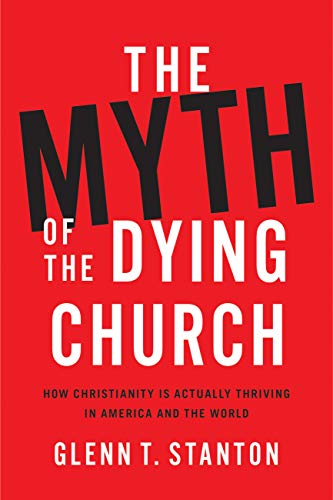By: Dr. Jim Denison – denisonforum.org – September 5, 2019
Every day brings more evidence that the church in America and the Western world is on a path to imminent demise:
- Millennials are leaving by the droves.
- The number of Americans with no religious commitment is skyrocketing.
- Churches are dying all around us.
- The future of America looks far more secular than spiritual.
Every statement I just made is false.
Glenn Stanton is director of Global Family Formation Studies at Focus on the Family. He served the George W. Bush administration for many years as a consultant on increasing fatherhood involvement. He is the author of nine books and one of the most insightful commentators on American culture today.
In his new book, The Myth of the Dying Church: How Christianity Is Actually Thriving in America and the World, Stanton explores the best sociological research available today on the subject of religious commitment in America and beyond. What he discovers runs directly counter to the cultural narrative that insists that Christianity is in steep decline.
To the contrary, he finds remarkable good news for the gospel in our day. And he offers very practical advice for parents who want to help the next generation stay faithful to Christ.
Here are Stanton’s conclusions:
- Church attendance is at an all-time high, both in raw numbers and as a percentage of the population.
- “The percentage of young adults regularly attending evangelical and nondenominational churches has roughly doubled between 1972 and today.”
- The “Nones” (those who say they have no religious affiliation) are not new unbelievers but people who were never committed to the faith and now feel free to tell pollsters so.
- “The number of Christians in the world today is larger than it has ever been in the history of the world.”
Why religion matters
In the foreword, Baylor scholar Byron Johnson states: “There is indeed a dramatic decline among some American churches, but this severe decline can be found in a distinct group of churches found within theologically liberal mainline Protestantism.”
“On the other hand,” Johnson notes, “theologically conservative denominations (evangelical churches, Pentecostal churches, and especially non-denominational churches) are not in decline but are alive and well.”
Johnson then observes that remarkable good comes from religious activity, not only for the religious but for society as a whole. He cites a study indicating that religion contributes approximately $1.2 trillion to the US economy each year. Thus, “the strength and vibrancy of the church today has vast consequences, impacting personal and societal well-being for everyone.”
Nine out of ten Americans, whether part of a church or not, agree that churches are a wholesale benefit to their communities. Three-quarters say churches play a key and positive role in upholding and protecting morality in their communities.
Surprisingly, 81 percent of unaffiliated Americans and 75 percent of atheists say the church serves an important role in bringing people together and strengthening community bonds. Only 7 percent of American adults express mostly negative views about churches.
Countering the secularization thesis
Stanton contrasts these facts with the “secularization thesis,” which he defines as “the idea that modern life, cultural advancement, the abundance of material possessions, and the dominance of a scientific worldview inevitably translate into a culture where religion becomes increasingly irrelevant and relegated to the blue-hair pensioners and a few superstitious, anti-science hangers-on.”
A study conducted by two scholars, one from Harvard and the other from the University of Indiana, found: “Rather than religion fading into irrelevance as the secularization thesis would suggest, intense religion—strong affiliation, very frequent practice, literalism and evangelicalism—is persistent, and in fact, onlymoderate religion is on the decline in the United States” (their italics).
Examples:
- Believers who pray many times a day have increased more than 8 percent since 1991. Those who attend church services more than once a week rose slightly.
- Evangelicals have grown from 18 percent of the population in 1972 to 28 percent today. However, mainline Protestants have declined from 35 percent of the American population in 1972 to 12 percent today.
- The only religious group that has grown is those who were more robust and traditional in their beliefs and practices, increasing from 39 percent of all church attenders in 1989 to 47 percent in 2017.
Baylor sociologist Rodney Stark adds: the percentage of Americans who attend a local church (not necessarily weekly) has grown from 17 percent in 1776 to 34 percent in 1850, 51 percent in 1906, and 69 percent today.
The number of weekly attenders from all denominations has fallen from 44 percent in the mid-1950s to 35 percent today. However, nearly all of this decline is found in the liberal churches.
According to a Pew study, mainline Protestant churches declined by five million adult members between 2007 and 2014. However, evangelical churches grew in absolute numbers by about two million during this same time.
Nondenominational churches gain roughly five new members for every one they lose to religious switching. The nones are not coming from the more conservative Protestant churches. To the contrary, they are “folks who are simply being more honest and accurate in their description of where they have always been in terms of their belief and practice.”
Stanton concludes: “It’s the ‘nons’ [nondenominational churches] and not the ‘nones’ that are mushrooming.” He states: “There is simply no evidence that secularism is increasing in the United States or that faithful, biblical Christianity is collapsing. . . . The correct demonstrations of faith are growing, and the false ones are shriveling.”
I would add this observation: the secularization thesis is embraced by secular people and advanced by secular media because it advances their secular worldview and agenda. If evangelicals are not diligent in countering this narrative and advancing God’s kingdom, it could become a self-fulfilling prophecy.
Why liberal churches are declining […]
The health of the global church […]
Youth and the future of the church […]
What is the future of the church? […]
Conclusion: The power of the Holy Spirit […]
To see the remainder of this article and others from Dr. Denison, click read more.
Source: Is the church nearly dead? Dr. Denison reviews ‘The Myth of the Dying Church’ – Denison Forum
 Listen Online
Listen Online Watch Online
Watch Online Find a Station in Your Area
Find a Station in Your Area










 Listen Now
Listen Now Watch Online
Watch Online
